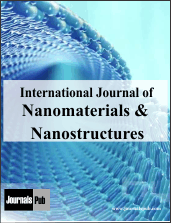Open Access

Prafull B. Dandge

Kalyanrao M. Garadkar

Padma B. Dandge

Pranoti N. Kirdat

Suyog S. Mane
- Research Scholar Shivaji University Kolhapur, Maharashtra India
- Professor Shivaji University Kolhapur, Maharashtra India
- Associate Professor Shivaji University Kolhapur, Maharashtra India
- Research Scholar Shivaji University Kolhapur, Maharashtra India
- Research Scholar Savitribai Phule Pune University Pune Maharashtra India
Abstract
Chemical synthesis is one of the commonly used method for nanoparticles synthesis. Different chemicals acts as reducing agents which converts chemical precursor into its nano form. There are various chemical methods for the synthesis of zero valent silver nanoparticles. The silver nitrate is commonly used as precursor, sodium borohydride acts as reducing agent while sodium dodecyl sulphate stabilizes the formation of nanoparticles. The formation of silver nanoparticles was characterized by UV-visible spectroscopy, Fourier transform infrared spectroscopy (FTIR) X-ray diffraction technique (XRD) and Scanning electron microscopy (SEM). The silver nanoparticles showed characteristic peak at 431 nm. The different functional groups attached to it were analyzed by FTIR spectroscopy. In X-ray diffraction analysis of nanoparticles, it showed highest peak at (111) crystal plane with 2 θ value 34.00. The hexagonal structure of silver nanoparticles was determined by SEM analysis. The zero valent silver nanoparticles synthesized by chemical reduction method have antimicrobial activity against Gram positive and Gram negative bacteria. It showed 18 mm and 21 mm zone of inhibition against Escherichia coli and Staphylococcus aureus micro-organism respectively. The dye degradation ability of silver nanoparticles was tested against organic dyes. The synthesized nanoparticles effectively degrade methylene blue dye within 24 hours. Thus, chemically synthesized zero valent silver nanoparticles were effectively utilized for biomedical and environmental applications.
Keywords: Zero valent silver nanoparticles, Silver nitrate, Antimicrobial activity, Dye degradation, FTIR spectroscopy, XRD and SEM.
References
1. Senthilkumar, N., Raadha, S.S. and Udayavani, S., 2015. Synthesis and Characterization of Silver Nanoparticle by Chemical Route Method. International Journal of Production Engineering, 1 (1), pp. 25–34.
2. Prasad, R., and Swamy, V.S., 2013. Antibacterial activity of silver nanoparticles synthesized by bark extract of Syzygium cumini. Journal of Nanoparticles, 2013.
3. Maiti, S., Krishnan, D., Barman, G., Ghosh, S.K. and Laha, J.K., 2014. Antimicrobial activities of silver nanoparticles synthesized from Lycopersicon esculentum extract. Journal of analytical science and technology, 5 (1), pp.1–7.
4. Bhakya, S., Muthukrishnan, S., Sukumaran, M., Muthukumar, M., Kumar, S.T. and Rao, M.V., 2015. Catalytic degradation of organic dyes using synthesized silver nanoparticles: a green approach. Journal of Bioremediation & Biodegredation, 6 (5), p.1.
5. Kumari, R.M., Thapa, N., Gupta, N., Kumar, A. and Nimesh, S., 2016. Antibacterial and photocatalytic degradation efficacy of silver nanoparticles biosynthesized using Cordia dichotoma leaf extract. Advances in Natural Sciences: Nanoscience and Nanotechnology, 7 (4), p.045009.
6. Mostafa, A.A., Sayed, S.R., Solkamy, E.N., Khan, M., Shaik, M.R., Al-Warthan, A. and Adil, S.F., 2015. Evaluation of biological activities of chemically synthesized silver nanoparticles. Journal of Nanomaterials, 2015.
7. Lee, S.M., Song, K.C. and Lee, B.S., 2010. Antibacterial activity of silver nanoparticles prepared by a chemical reduction method. Korean Journal of Chemical Engineering, 27(2), pp. 688–692.
8. Khatoon, U.T., Rao, K.V., Rao, J.R. and Aparna, Y., 2011, November. Synthesis and characterization of silver nanoparticles by chemical reduction method. In International Conference on Nanoscience, Engineering and Technology (ICONSET 2011) (pp. 97–99). IEEE.
9. Zhang, X.F., Liu, Z.G., Shen, W. and Gurunathan, S., 2016. Silver nanoparticles: synthesis, characterization, properties, applications, and therapeutic approaches. International journal of molecular sciences, 17 (9), p.1534.
10. Jyoti, K., Baunthiyal, M. and Singh, A., 2016. Characterization of silver nanoparticles synthesized using Urtica dioica Linn. leaves and their synergistic effects with antibiotics. Journal of Radiation Research and Applied Sciences, 9 (3), pp. 217–227.
11. Chand, K., Cao, D., Fouad, D.E., Shah, A.H., Dayo, A.Q., Zhu, K., Lakhan, M.N., Mehdi, G. and Dong, S., 2020. Green synthesis, characterization and photocatalytic application of silver nanoparticles synthesized by various plant extracts. Arabian Journal of Chemistry, 13 (11), pp. 8248–8261.
12. Vanaja, M., Paulkumar, K., Baburaja, M., Rajeshkumar, S., Gnanajobitha, G., Malarkodi, C., Sivakavinesan, M. and Annadurai, G., 2014. Degradation of methylene blue using biologically synthesized silver nanoparticles. Bioinorganic chemistry and applications, 2014.
13. Senthil, B., Devasena, T., Prakash, B. and Rajasekar, A., 2017. Non-cytotoxic effect of green synthesized silver nanoparticles and its antibacterial activity. Journal of Photochemistry and Photobiology B: Biology, 177, pp. 1–7.
14. Gudikandula, K. and Charya Maringanti, S., 2016. Synthesis of silver nanoparticles by chemical and biological methods and their antimicrobial properties. Journal of Experimental Nanoscience, 11 (9), pp. 714–721.
15. Guzmán, M.G., Dille, J. and Godet, S., 2008. Synthesis of silver nanoparticles by chemical reduction method and their antibacterial activity. International Journal of Materials and Metallurgical Engineering, 2 (7), pp. 91–98.
16. Chahar, V., Sharma, B., Shukla, G., Srivastava, A. and Bhatnagar, A., 2018. Study of antimicrobial activity of silver nanoparticles synthesized using green and chemical approach. Colloids and Surfaces A: Physicochemical and Engineering Aspects, 554, pp. 149–155.
17. Anjana, R. and Geetha, N., 2019. Degradation of methylene blue using silver nanoparticles synthesized from Cynodon dactylon (L.) Pers Leaf aqueous extract. Int J Sci Technol Res, 8 (9), pp. 225–229. 18. Al-Zaban, M.I., Mahmoud, M.A. and AlHarbi, M.A., 2021. Catalytic degradation of methylene blue using silver nanoparticles synthesized by honey. Saudi Journal of Biological Sciences, 28 (3), pp.2007–2013.

International Journal of Nanomaterials and Nanostructures
| Volume | |
| Received | November 18, 2021 |
| Accepted | November 22, 2021 |
| Published | January 22, 2023 |

